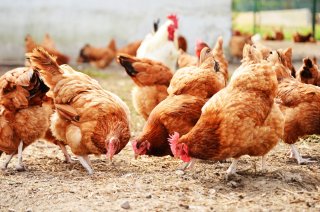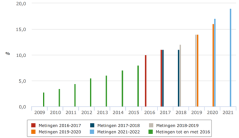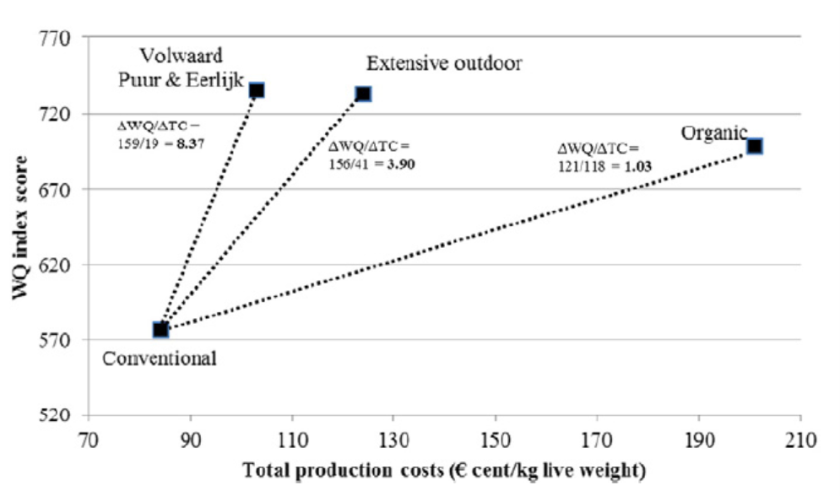
Longread
Animal welfare and the market: we need to measure
In this longread, we look at how the animal welfare market has developed in the Netherlands and what the market drivers are. We also call for animal-based measures as a way of raising standards of animal welfare in the Netherlands.
Making a start
For a long time, there’s been an assumption that consumers can act as a driving force in improving animal welfare standards. While the government guarantees minimum animal welfare standards through statutory regulations, market forces were expected to drive demand for products with higher, non-statutory animal welfare requirements. Eventually, this would raise the bar for the statutory minimum. The ‘Volwaard’ chicken is a good example of this approach. The concept for this chicken came about as a result of growing resistance among consumers to the increasingly fast-grown broiler chickens. The Volwaard chicken is a slower-growing breed, reared in lower densities and with access to a covered outdoor area. Volwaard poultry meat was introduced to the market in 2007.
The Dutch Society for the Protection of Animals developed the Beter Leven ('Better Life') quality label as a way of supporting sales of the Volwaard chicken (Boerderij, 2017). The quality label has three levels of improved animal welfare (one, two and three stars), with organic production allocated three stars. In 2008, the Volwaard chicken was the first product to be awarded the 1 star Beter Leven quality label. The Volwaard chicken also inspired the covenant on Developing the Market for more Sustainable Animal Products which Gerda Verburg, then Minster of Agriculture, Nature and Food Quality established in 2009 with poultry and livestock sector organisations, meat processors, the Dutch Food Retail Association (CBL), the Association of Dutch Catering Organisations (Veneca), Royal Dutch Butchers (KNS) and the Dutch Society for the Protection of Animals. The aim of the covenant, which ran through to the end of 2011, was to increase sales of sustainable animal products by 15% annually. It focused on developing the production of eggs, poultry meat and pork with explicitly higher animal welfare standards. These higher standards translated into 1 or 2 stars under the Beter Leven quality label.
The market gains momentum
The first Sustainable Food Monitor appeared in May 2011, giving an overview of consumer spending on sustainable products from supermarkets in 2009 and 2010. The monitor included ‘higher welfare products’ . This covered organic products, and products labelled as Beter Leven, Label Rouge, free-range, barn-laid ‘plus’ eggs and Milieukeur, the Dutch eco-label. In 2009, consumer spending as a whole amounted to 37.6 billion euros, with sustainable products accounting for 1 billion euros or 2.5% (Figure 1). Of that amount, 25% (258.2 million euros) went on sales of higher welfare products.
Sales of pork certified with 1 star under the Beter Leven quality label have been growing since 2011, when Albert Heijn became the first supermarket to switch to selling fresh pork under that label. Other supermarkets followed suit. The poultry sector introduced the ‘Kip van Morgen’ (‘Chicken of Tomorrow’) concept, selling meat from slower-growing chicken breeds. The concept led to an improvement in animal welfare but was not associated with a particular quality label. Sales of ‘Chicken of Tomorrow’ concepts are therefore not included in the Sustainable Food Monitor figures. In 2014, Albert Heijn introduced the ‘Hollandse Kip’ (‘Dutch Chicken’) under the ‘Chicken of Tomorrow’ concept. The Jumbo supermarket chain soon followed with its New Standard Chicken. Other retailers did the same, and by 2017 all fresh poultry meat was at least of the ‘Chicken of Tomorrow’ standard. Meanwhile, chicken certified with 1 star under the Beter Leven quality label had been increasing its market share since 2015, and eventually it replaced the ‘Chicken of Tomorrow’ concepts on supermarket shelves.

In 2021, consumer spending as a whole came to 50.6 billion euros, with sustainable products accounting for 9.5 billion euros or about 19% (Figure 1). Sales of higher welfare products accounted for 40% of this (3.9 billion euros). The proportion spent on sustainable products has increased as a whole, and so too has the proportion spent on higher welfare products. This includes: Organic, Beter Leven, Label Rouge, free range and On the way to PlanetProof, which has succeeded the Milieukeur eco-label. This quality label was introduced in 2017 and can be found on products including potatoes, onions, fruits and vegetables, herbs, dairy, eggs, and drinks. On the way to PlanetProof is based on a comprehensive approach to making products and services more sustainable. For dairy, this means there are additional requirements related not just to animal welfare and health but also to other issues such as soil, landscape, biodiversity and energy. In 2021, On the way to PlanetProof increased its sales across all product groups by 32% as a result of scaling up its supermarket sales channels.
The growth in sales of higher welfare products between 2009 and 2022 is partly down to the growth in sales of 1 star Beter Leven products. All fresh pork on sale in Dutch supermarkets now holds the 1 star Beter Leven quality label, and it’s anticipated that by 2023 all fresh chicken will too. This is clearly a success story.
And was it driven by the market power of consumers? Not really. It was the supermarkets that led the way, with social pressure driving them to modify their whole product range, leaving no room on the shelf for conventional products. Saatkamp et al. (2019) describe how the animal-rights activist organisation Wakker Dier used a campaign against the ‘plofkip’ (the bloated, factory-farmed chicken) to pressurise supermarkets into offering higher welfare chicken. Measures were also introduced to make it more cost-effective for livestock keepers to improve animal welfare standards. Pig and poultry farmers operating under the 1 star Beter Leven quality label could, for example, claim the expense of applying those higher standards back from their buyers. Competition among retailers in relation to their public image was in fact a greater driver of change than consumer
demand. We will return to the issue of cost-effectiveness below.
Where is the market heading now?
Can the successes of the domestic market be translated to the international market? That would be great, because the domestic market accounts for about a third of all pork and chicken production. Two thirds goes to the hospitality or catering industries, but mostly overseas. The animals destined for those markets are mostly reared in accordance with the minimum statutory animal welfare standards. This means there are some big wins to be had with the export market. Almost everywhere in Northwest Europe there are now quality labels for non-statutory animal welfare standards, and products meeting these non-statutory animal welfare standards have appeared on the market. Unfortunately, animal welfare organisations and/or governments did not align the various quality labels from the start. The ‘Advancing sustainable animal products’ project is now trying to work with organisations in the sector to harmonise the quality labels, but it’s a slow process. So for now, the European market for products with non-statutory animal welfare standards is highly segmented: each country supplies products for its own domestic market or supermarket. It means that meat producers working under a particular quality label have to closely align their output to domestic demand, because any excess production has to be a sold at a price that doesn’t reflect the quality label standards, which generally means it fetches a lower price. This already happens in any event for parts of the chicken and pig carcass that aren’t eaten in the Netherlands and therefore have to be sold abroad.
What could be done to increase sales of higher welfare products on the domestic market? Could more be sold to the hospitality and catering sectors? Absolutely. That market is changing too: 200 businesses have signed the Better Chicken Commitment, promising to source higher welfare chicken (Boerderij, 2021). Or could animal welfare standards be made stricter? The question is whether that would actually improve animal welfare, and at what cost. Those costs are generally transparent: for example, Van Horne (2021) calculated that the ‘Chicken of Tomorrow’ concept translates into a 20% greater cost to the broiler chicken producer compared to a conventional chicken producer, while 1 star Beter Leven means a 44% cost increase and organic production (3 star Beter Leven) means a 193% cost increase. Those are significant cost increases. But what’s the impact on animal welfare? The only way to really find out is by actually measuring animal welfare.
Animal welfare is measurable
Measuring animal welfare among livestock was exactly the point of the European Welfare Quality Project, which started in 2004. The project aimed to measure welfare using animal-based measures (animal characteristics) rather than just describing it based on prescribed rules or environmental characteristics such as livestock density and access to stimuli. The EU and the Dutch government both made a substantial investment in the project. It concluded in 2010 with scientifically tested protocols for measuring animal welfare in cattle (not veal calves), pigs, broilers and laying hens (www.welfarequality.net). The protocols are used to give scores in four areas: normal behaviour, good health (absence of illness and injury), good feed and good housing. The scoring in the first two areas uses animal-based measures based on individual animals or groups of animals, and for the latter two areas it’s based on prescribed rules. Unfortunately, these protocols turned out to be too time-consuming and therefore too expensive to be applied at individual livestock farms. For example, in Belgium, the Flanders Research Institute for Agriculture, Fisheries and Food (ILVO) has now developed an app based on the protocols which livestock keepers can use to score animal welfare on their farm. Thanks to the app, measuring animal welfare is no longer quite so complicated. Other, similar initiatives also exist.
De Jong et al. (2022), using measurements based on these protocols, conclude that the broilers in the ‘Chicken of Tomorrow’ concepts and those reared under the 1 star Beter Leven standard have, on average, higher levels of animal welfare than conventionally reared broilers. This still holds true when the scores based on prescribed rules are left out and the score is based solely on animal-based measures. Conventional broiler chicken farms achieve lower scores for most of the animal-based indicators. There is in fact a broad spectrum of outcomes for every production system, though 1 star Beter Leven is more consistent. This could be because those farmers who comply with stricter animal welfare requirements are better able to apply those animal welfare practices or because they have a more robust system that is less sensitive to management effects. The findings show that there is room for improvement in all production systems.
In earlier research, Gocsik et al. (2016) used the protocols to make an expert estimate of animal welfare among:
- conventional poultry meat production,
- the Volwaard barn-reared chicken that served as the model for 1 star Beter Leven,
- free-range chickens (comparable to 2 star Beter Leven) and
- organic chickens (3 star Beter Leven).
Figure 2 below is reproduced from that research. The vertical axis shows the animal welfare score and the horizontal axis shows the cost of producing these chickens (in euro cents per kilogram of live weight). The figure shows how moving to 1 star Beter Leven delivers the biggest win for animal welfare in livestock, because under the 2 or 3 star Beter Leven label the level of animal welfare actually declines slightly compared to 1 star. This is due to a handful of lower scores for some animal-based measures. The additional requirements for the 2 and 3 star Beter Leven quality labels, such as a free-range system, don’t actually add anything to animal welfare. But they do add to production costs. The cost-effectiveness of these systems (animal welfare benefits set against the additional costs compared to conventional poultry meat production) is lower in these systems than under the 1 star Beter Leven system.

However, there are some things to note in interpreting these results. Firstly, it may be different in other sectors. Outcomes for the pig farming sector are similar (Hoogstra, 2019), but a German study found higher welfare among organic dairy cows than in conventional dairy cows (Wagner et al., 2021). Secondly, free-range systems introduce risks to welfare which are reflected in lower scores. There are certainly gains to be made by addressing those risks. Thirdly, current protocols for measuring animal welfare could be further improved by taking greater account of the behaviour and emotional status of the animal. Freedom of movement, sunlight and fresh air – characteristics of more extensive livestock systems – can have a positive influence there.
Measuring animal welfare is necessary
Animal-based measures can provide greater clarity not just to animals and livestock keepers but also to consumers and civil society. New quality labels that include animal welfare appeared on the market in the Netherlands in 2017. One of these is On the way to PlanetProof, mentioned above, and another is the ‘Beter voor’ (‘Better for’) quality label used by Albert Heijn. It’s hard to argue that these have improved transparency. The government seems to agree, having commissioned the environmental information organisation Milieu Centraal to clarify to consumers what all the different quality labels mean. In response, Milieu Centraal introduced a scoring system comparing all the premium labels. Animal welfare is one of the areas for which each quality label is assessed. Besides assessing animal welfare, the scores are also an assessment of how ambitious the quality labels are in terms of what they consider the maximum achievable outcome. In the meat category, the 1 star Beter Leven quality label, which would include poultry meat and pork sold under that label, achieves three out of five, indicating that there is much room for improvement in animal welfare for both of those products. The 1 star Beter Leven quality label is indeed not actually a premium label. We’ve described above how for the broiler sector this underestimates what’s been achieved for animal welfare over the past decade or so, because poultry meat labelled as 1 star Beter Leven is a significant improvement on conventional production in terms of animal welfare.
That’s why we’re calling for animal-based measures to be used for assessing animal welfare, so that we can establish whether animal welfare really is better in production systems that purport to improve it. Or so that livestock keepers can be rewarded for their efforts based on results, rather than on stars or marks out of five. These can lead to unnecessarily higher production costs for the sake of animal welfare. There may well be reasons for making livestock farming more extensive (to reduce the incidence of diseases, or nitrogen levels) but these are separate challenges. If we are to improve animal welfare, we need animal-based measures. The government (at both the national and EU level) can set rules to ensure that animal-based measures are used to assess animal welfare. For the EU, there’s an incentive to get rid of the current national segmentation across the European market, which after all is meant to be a single market. Doing so would benefit producers and give clarity to consumers as to whether a particular product really has been produced to higher welfare standards.
Elsje Oosterkamp and Luuk Vissers both work as market and chain researchers. Luuk Vissers has conducted a PhD research on sustainable poultry farming systems. Animal welfare and the 'intermediate segment' are a recurring subject in Elsje Oosterkamp's research.
The authors would like to thank Ingrid de Jong, senior scientific researcher poultry behavior and welfare from Wageningen Livestock Research for critically reading this longread.
